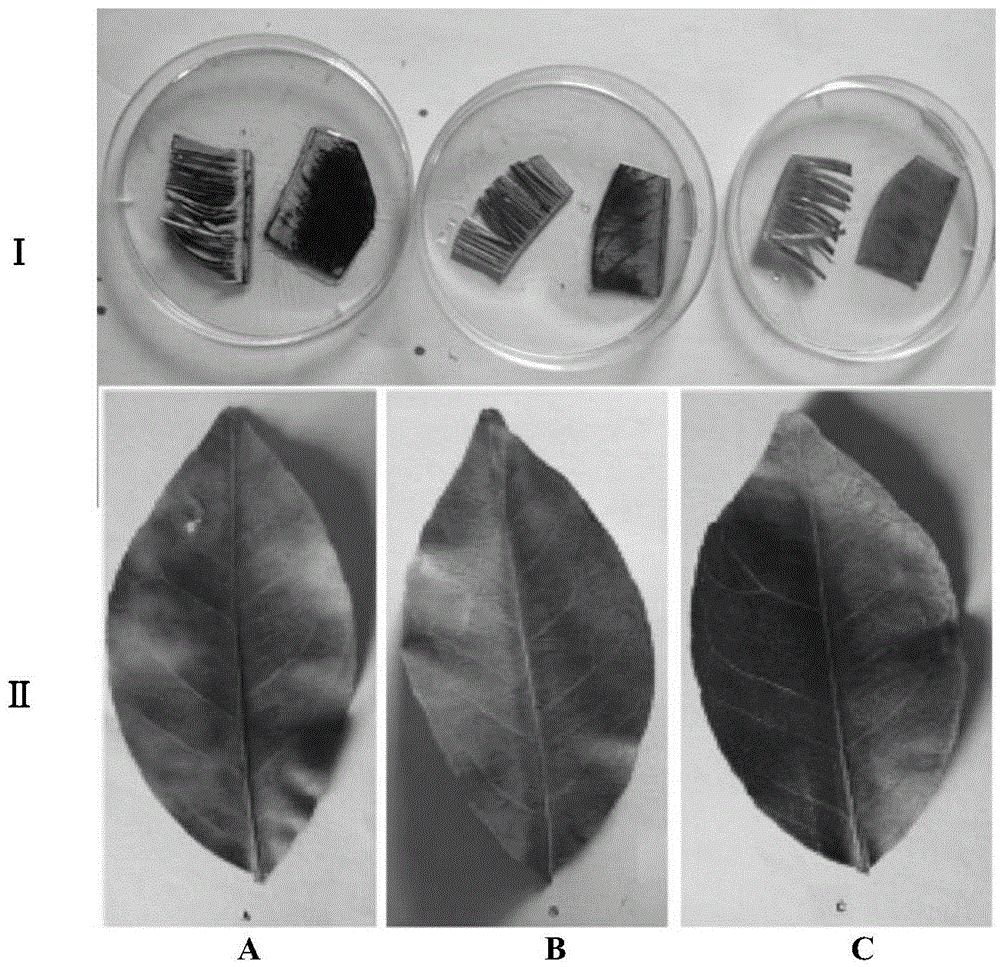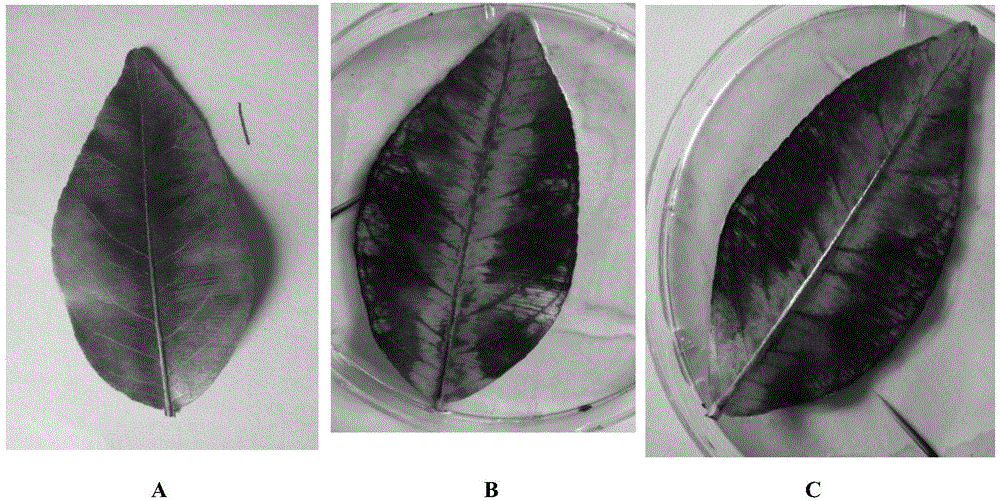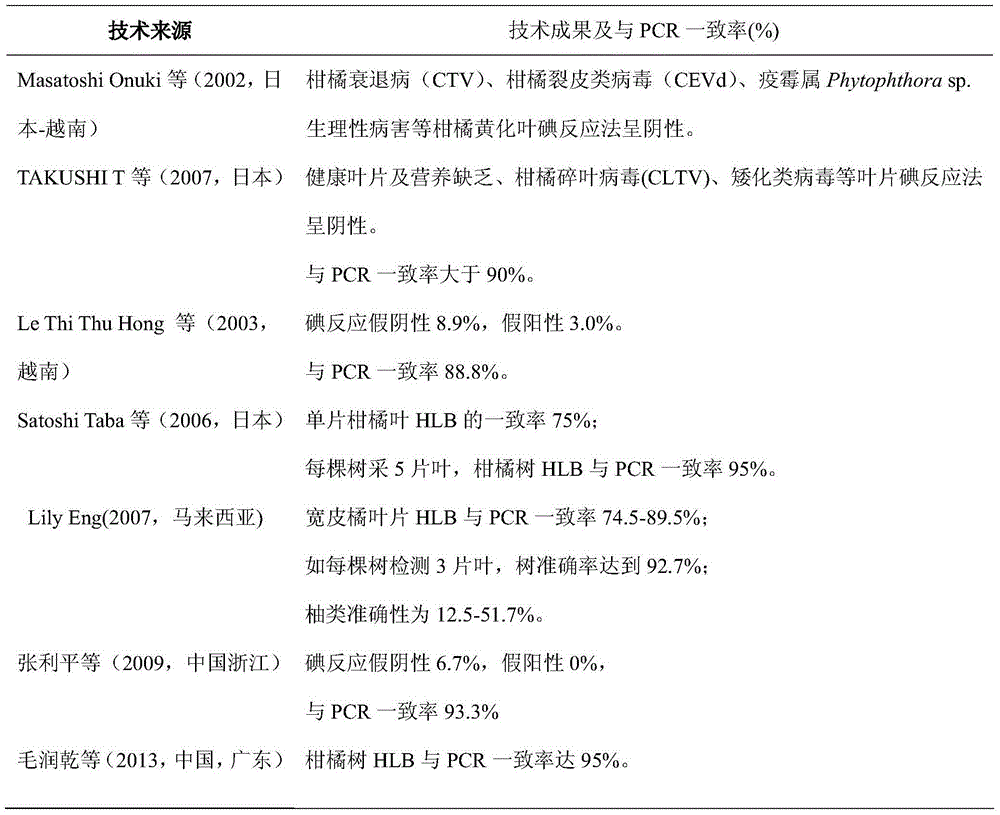Citrus greening disease rapid detection method
A citrus huanglongbing and detection method technology, which is applied in the preparation of test samples, analysis through chemical reaction of materials, and material analysis through observation of the impact on chemical indicators, can solve the impact judgment, freezing and decolorization time Long time, long time and other problems, to achieve the effect of ensuring integrity, short decolorization time and maintaining consistency
- Summary
- Abstract
- Description
- Claims
- Application Information
AI Technical Summary
Problems solved by technology
Method used
Image
Examples
Embodiment 1
[0033] Cover the citrus leaves to be detected with a black bag, seal the seal, and perform dark treatment for 12 hours to obtain dark-treated citrus leaves to be detected. Select Huanglongbing infection leaf (symptomatic leaf), Huanglongbing infection leaf (asymptomatic leaf) and normal health leaf three kinds of blades therefrom respectively, every kind of blade is divided into two halves, handles with following method respectively:
[0034] 1. Cut the citrus leaves to be tested into thin strips about 1mm wide, put them in the refrigerator to freeze at -10°C, take them out after 24 hours and put them in chlorophyll decolorization solution (acetone) for decolorization, after 10 hours, the thin strips of leaves become For white leaves, pour off the decolorizing solution, add starch color developing solution (iodine) to develop color, observe the change of leaf color for diagnosis, if the leaves turn blue, it means that the citrus leaves to be tested are leaves infected by Huangl...
Embodiment 2
[0041] In a sugar orange orchard in Yunan County, on May 28, 2014, the citrus leaves to be tested were covered with black bags, sealed, and dark-treated for 24 hours to obtain dark-treated citrus leaves to be tested. Gently grind the citrus leaves to be tested with glass sandpaper to grind off the waxy layer on the surface of the leaves, put the leaves in chlorophyll decolorization solution (acetone) for 2 hours for decolorization, the leaves turn white, pour off the chlorophyll decolorization solution , add starch color solution (iodine) to the leaves after decolorization, and observe the color change of the leaves. If the leaves turn blue, it means that the citrus leaves to be tested are leaves infected with Huanglongbing. If the leaves do not change color, they are normal leaves. . A color change is found after 1 minute, such as figure 2 As shown, it can be seen that the citrus leaves to be tested are citrus Huanglongbing infected leaves. It is the same as the detection ...
Embodiment 3
[0043] In a sugar orange orchard in Yunan County, at 3 o'clock in the afternoon on May 28, 2014, the citrus leaves to be tested were covered with black bags, sealed, and the dark treatment was completed. Sampling was completed at 11:30 on the 29th, with a total of 50 samples Tree. The citrus leaves to be tested (cut from the same piece) were divided into two processing methods.
[0044] 1. Gently polish the citrus leaves to be tested with glass sandpaper to remove the waxy layer on the surface of the leaves. Put the leaves into the chlorophyll decolorization solution (acetone) for 2 hours to decolorize the leaves. The leaves turn white and pour off the chlorophyll. Decoloring solution, drip starch color developing solution (iodine) on the leaves after decolorization, observe the color change of the leaves, if the leaves turn blue, it means that the citrus leaves to be detected are leaves infected by Huanglongbing, if the leaves do not change color, it is normal leaves. A col...
PUM
 Login to View More
Login to View More Abstract
Description
Claims
Application Information
 Login to View More
Login to View More - R&D
- Intellectual Property
- Life Sciences
- Materials
- Tech Scout
- Unparalleled Data Quality
- Higher Quality Content
- 60% Fewer Hallucinations
Browse by: Latest US Patents, China's latest patents, Technical Efficacy Thesaurus, Application Domain, Technology Topic, Popular Technical Reports.
© 2025 PatSnap. All rights reserved.Legal|Privacy policy|Modern Slavery Act Transparency Statement|Sitemap|About US| Contact US: help@patsnap.com



